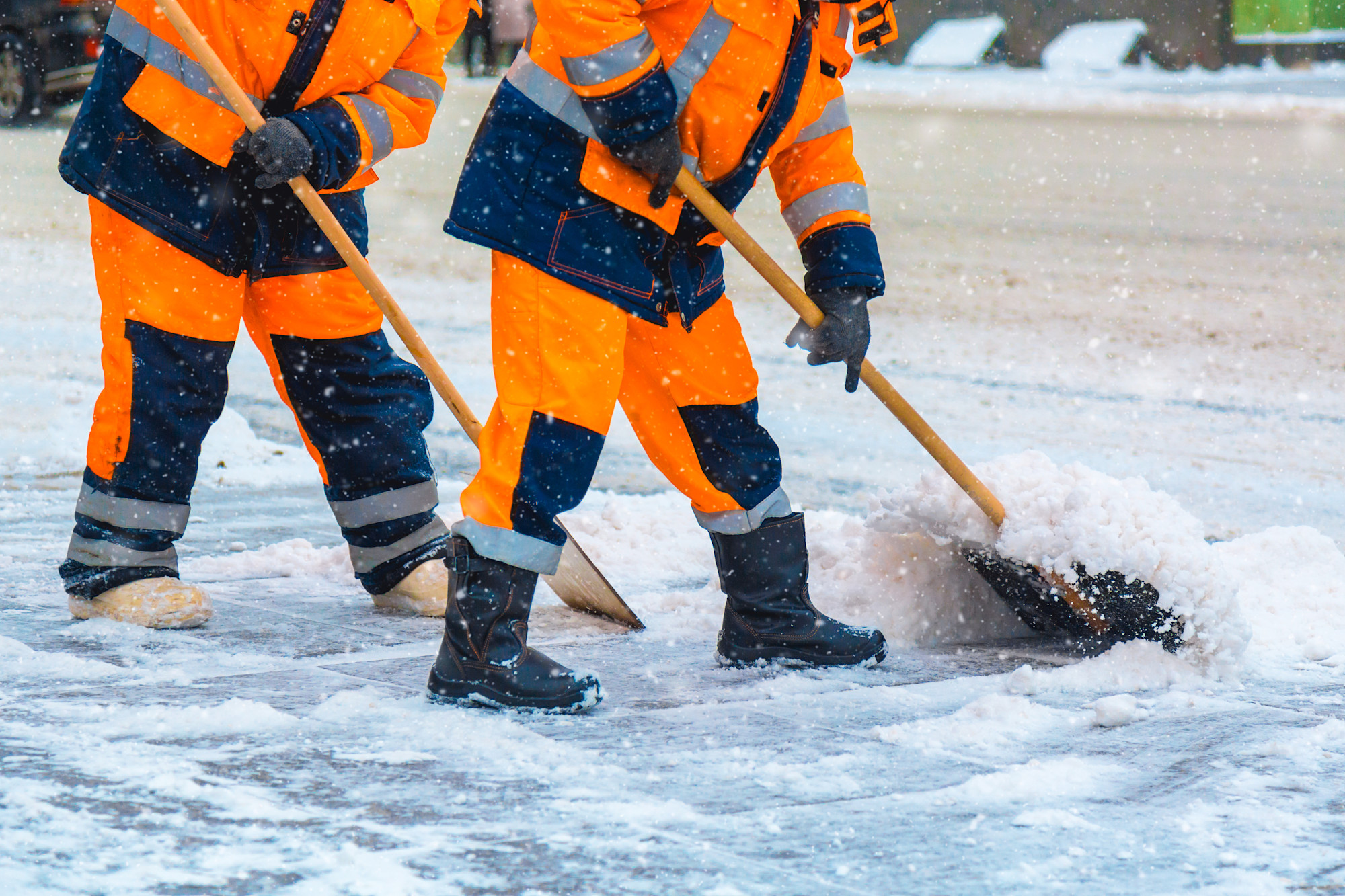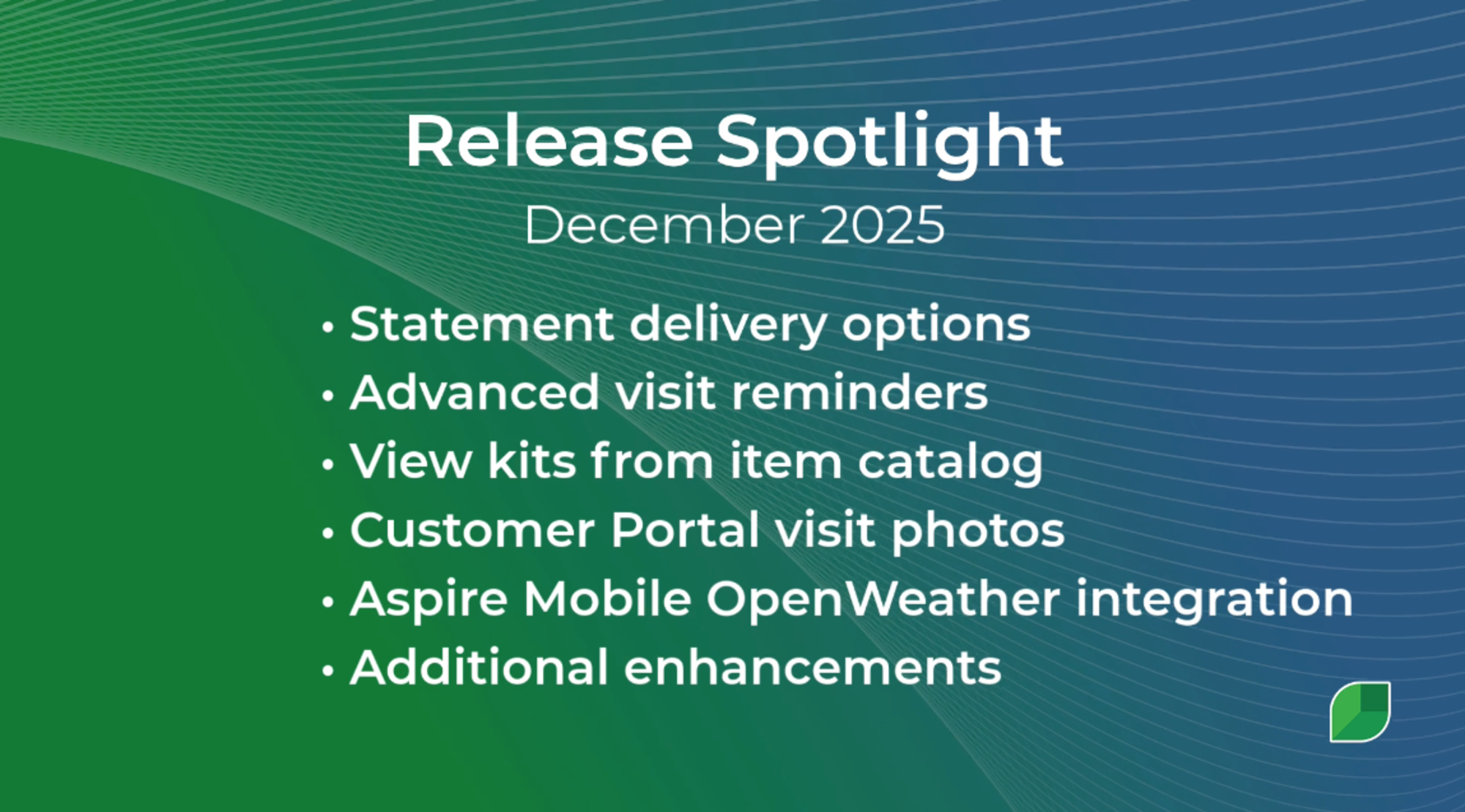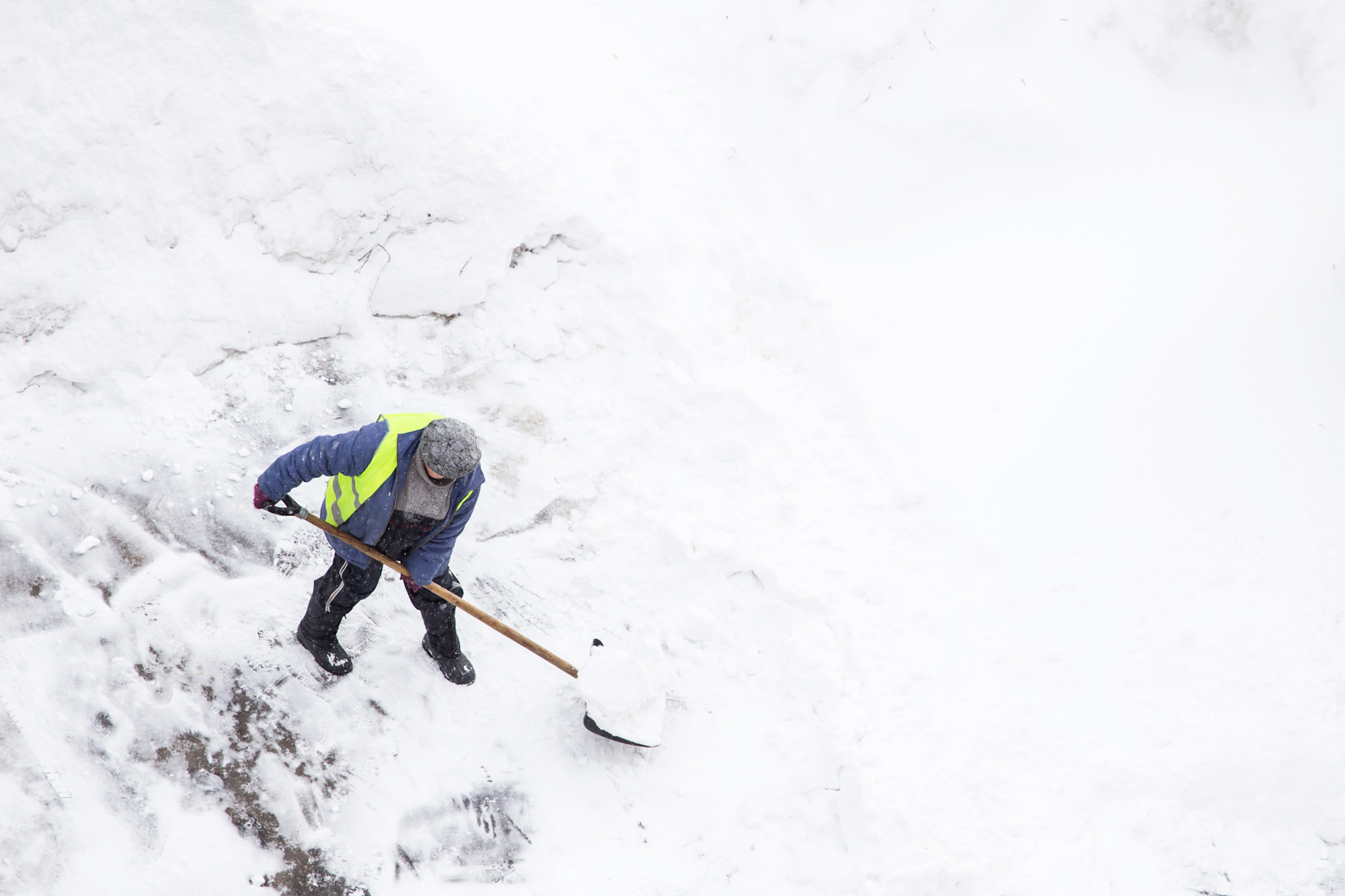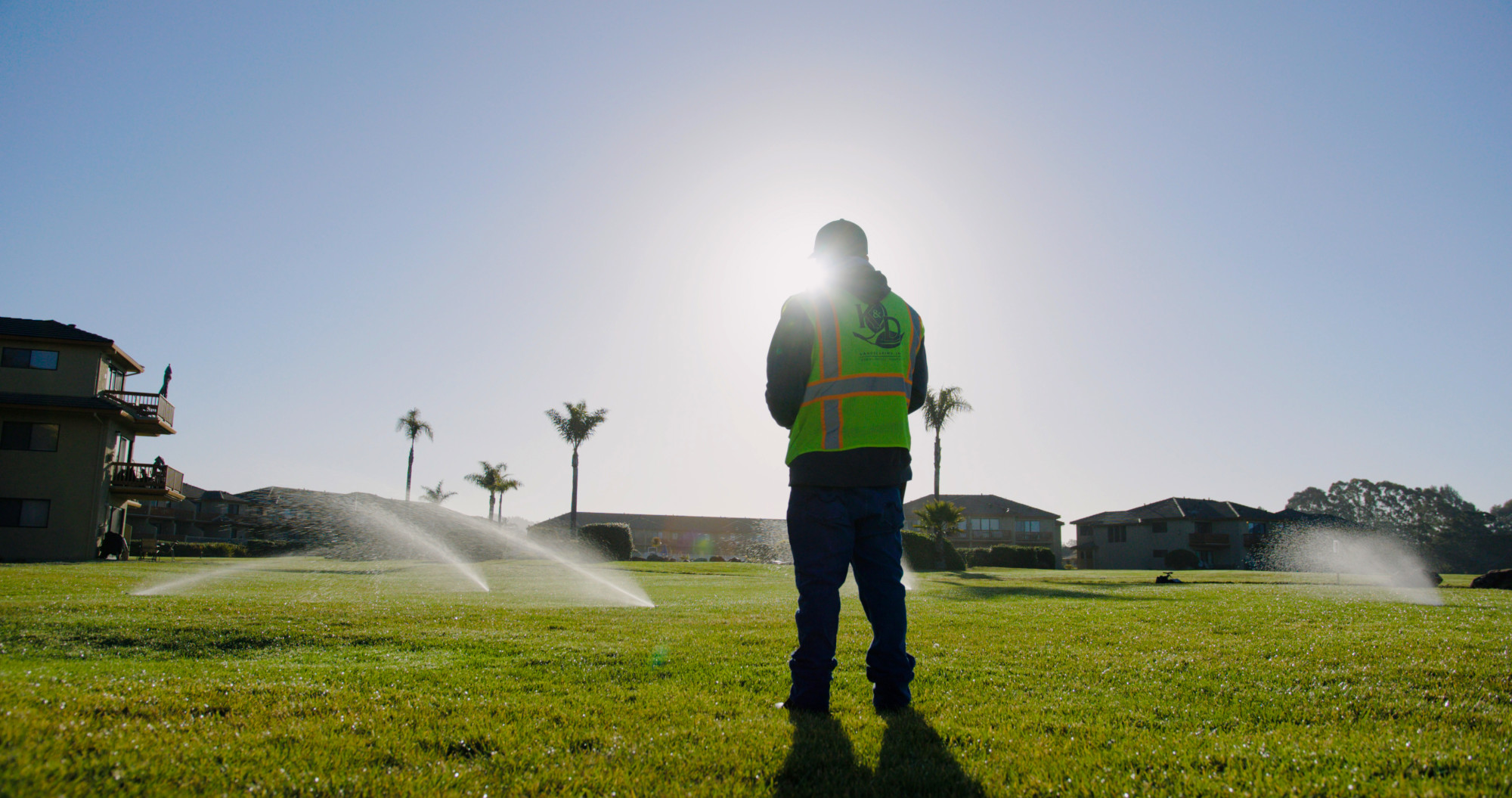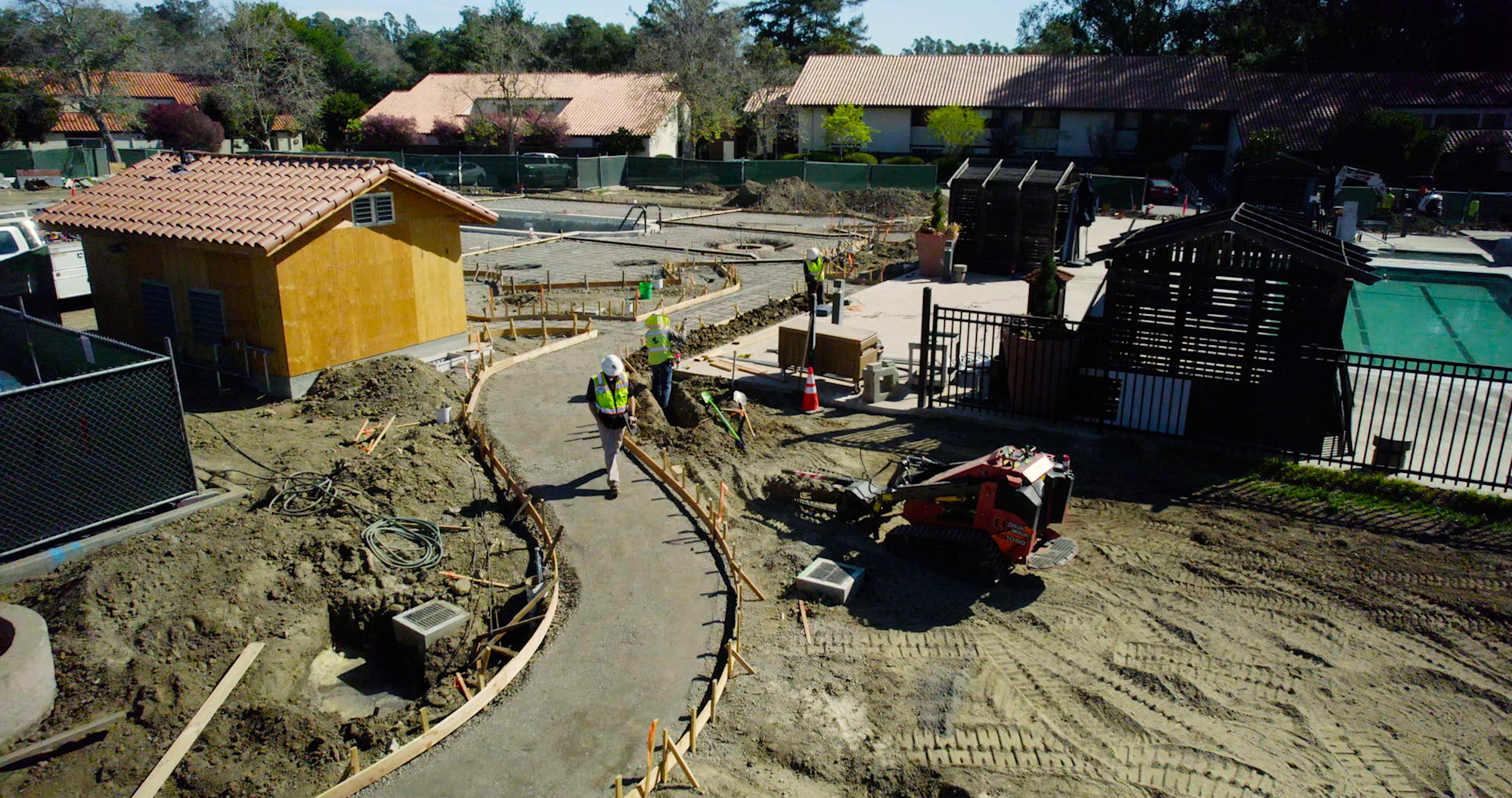Table of Contents
Table of Contents
- 1. Stockpile Salt Before Your Competitors Do
- 2. Test Every Piece of Equipment (Yes, Even the Old Plow in the Corner)
- 3. Train Crews on Safety Before the Ice Hits
- 4. Check Insurance—Because Slip-and-Fall Season Is Real
- 5. Build Your Route Plans. Don’t Wing It
- 6. Confirm Contracts and Pricing Before Clients Start Calling
- 7. Double-Check Your Invoicing System Works in Real-Time (The Big One)
- The Aspire advantage for real-time invoicing:
- 8. Prep Backup Plans for Crew Call-Outs
- 9. Make Sure Fuel Supplies Won't Run Dry Mid-Blizzard
- 10. Embrace Tech—It's the Only Way to Scale Without Losing Your Mind
- Crush the snow season with confidence
Snow season is coming.
One minute you're enjoying crisp fall weather and contemplating weekend plans, and the next minute you're getting weather alerts about the first major storm hitting in 72 hours. Miss these 10 critical steps, and you'll be knee-deep in chaos (and snowdrifts) before you know it.
Most contractors swear they're ready for winter.
They survived last season, their equipment is "probably fine," and they've got a mental list of things to handle "soon." Then the first storm hits, and suddenly that confidence evaporates faster than snow on hot pavement when reality reveals all the preparation steps that got skipped.
The businesses that hit new revenue records during winter (not just scrape by until spring) are the ones that checked every box on this list before the first flake fell.
We're betting you haven't done #7—most contractors haven't, and it's the one that costs them the most money.
1. Stockpile Salt Before Your Competitors Do
Salt shortages happen every year, yet contractors are still caught off guard when supplies run low during the first major storm.
Don't be the contractor who raids Home Depot at 3 a.m., paying retail prices for consumer-grade bags because you waited too long to secure a bulk supply.
Strategic salt procurement includes:
Ordering early for better pricing
Calculating seasonal needs based on historical data
Securing storage space before you need it
Building supplier relationships before emergencies
Having backup supplier contacts
The peace of mind that comes from having adequate material stockpiled before winter hits is worth every penny of early investment, and you'll save money through better pricing and bulk purchasing power.
2. Test Every Piece of Equipment (Yes, Even the Old Plow in the Corner)
That backup plow sitting in the corner that hasn't moved since March?
It's probably not as ready as you think.
Fire up everything—and we mean everything—to catch issues before the storm hits.
Start engines, cycle hydraulics, test electrical systems, check fluid levels, inspect wear items, and operate equipment under realistic conditions. A five-minute test run in the parking lot doesn't count as comprehensive equipment testing.
Critical equipment testing includes:
Plows and mounting systems
Salt spreaders with all moving parts
Snowblowers are often neglected until needed
Vehicles that carry equipment
That "backup" equipment you're counting on
If you wince when you start it, it's definitely not storm-ready.
Unusual noises, sluggish responses, leaking fluids, or hesitant operation are all warning signs that need addressing now, not during a blizzard.
With Aspire's equipment management features, you can track maintenance schedules, log testing results, document issues discovered, and ensure nothing gets forgotten or overlooked. Systematic equipment tracking prevents the scenario where you find out critical failures when there's no time to fix them properly.
3. Train Crews on Safety Before the Ice Hits
Safety training before the snow season protects your crew members, reduces liability exposure, and prevents the accidents that derail operations and damage reputations.
Even veteran crew members who've worked multiple winters forget safety basics over the summer. Muscle memory fades, complacency creeps in, and dangerous shortcuts that seemed fine last season suddenly cause injuries this year.
Safety refreshers aren't optional—they're essential.
Comprehensive safety training covers:
Cold weather protection and frostbite prevention
Equipment operation safety protocols
Slip and fall prevention for crew members
Traffic safety during roadside operations
Chemical safety for salt and de-icer handling
Communication protocols for emergencies
Safety training also improves crew morale.
Workers who feel protected and valued stay longer, work harder, and speak positively about your company. Cutting corners on safety training sends the opposite message—that profit matters more than people.
4. Check Insurance—Because Slip-and-Fall Season Is Real
A single client injury, property damage claim, or crew member's workers' compensation case can financially devastate businesses without proper insurance coverage.
Clients increasingly expect proof of insurance before signing snow removal contracts.
They're not being difficult—they're being smart by ensuring contractors can cover damages if something goes wrong. If you're unable to provide current certificates of insurance, you're losing contracts to competitors who can.
Essential insurance coverage review includes:
General liability insurance with adequate limits
Commercial auto insurance for all vehicles
Current workers' compensation coverage
Professional liability coverage for contract disputes
Equipment and property coverage
Schedule an insurance review meeting with your agent, specifically focused on snow removal operations.
Discuss any changes in your business—new equipment, additional crews, expanded service area, or different service types—that might require coverage adjustments.
5. Build Your Route Plans. Don’t Wing It
The GPS shouldn't be figuring out your routes during the storm—that's a recipe for wasted fuel, missed properties, and crew confusion.
Pre-planned routes organized by geographic efficiency save time, reduce costs, and improve service consistency.
Randomly assigning jobs as calls come in might feel responsive, but it's operationally inefficient. Crews zigzag across your service area, burning fuel and time as some properties are served immediately while others wait hours unnecessarily.
Strategic route planning includes:
Geographic clustering that minimizes drive time
Priority tiering based on contract terms
Traffic pattern consideration for time-sensitive jobs
Crew skill matching to job complexity
Backup route plans for common complications
Tools like PropertyIntel's integration with Aspire provide digital property measurements and maps that make route planning more accurate. You can visualize properties, identify obstacles, and create directional maps showing snow pile storage locations and traffic flow.
Pre-planned routes also improve crew morale.
Nobody enjoys the stress of figuring out where to go next during a storm. Clear assignments with logical sequencing make everyone's job easier and more efficient.
6. Confirm Contracts and Pricing Before Clients Start Calling
If it's not on paper, it's just a handshake in a snowstorm—and handshakes don't hold up when disputes arise.
Signed contracts guarantee work, confirm pricing, establish service expectations, and provide legal protection when clients have selective memory about agreements.
Avoid the awkward miscommunications after storms when clients claim they were quoted different pricing or promised faster response times.
Written agreements eliminate ambiguity and protect both parties by documenting the exact terms.
Contract essentials that prevent disputes:
Specific pricing with clear terms
Service level agreements defining response times
Property-specific requirements and access information
Payment terms and billing schedules
Liability limitations and client responsibilities
Use Aspire's contract management features to store all signed agreements digitally with easy access from the office or the field. When clients call with questions about their agreement, you can reference exact terms immediately rather than searching through filing cabinets.
Digital contract storage also helps with renewals.
You can review last year's terms, adjust for inflation or changed circumstances, and send updated agreements for signature without having to recreate everything from scratch.
7. Double-Check Your Invoicing System Works in Real-Time (The Big One)
Here it is—the step most contractors skip, and the one that costs the most money.
Real-time invoicing that actually works during operational chaos separates profitable snow removal businesses from those that struggle financially despite doing great work.
Because chasing down clients after the thaw is a terrible business model, by the time snow melts and you finally get around to invoicing for services provided weeks ago, clients have forgotten the storms, question the charges, and drag out payment while your cash flow suffers.
Why real-time invoicing matters critically:
Cash flow maintenance during the expensive season
Accuracy while details are fresh
Reduced disputes through timely documentation
Prevention of lost revenue from missed billing
Competitive advantage through professional operations
The manual invoicing disaster scenario:
Picture this common situation: You just managed a massive three-day storm event. Crews worked around the clock, servicing 50+ properties and using tons of material, leaving everyone exhausted.
Now you need to create invoices manually by reconstructing what happened from scattered notes, crew reports, and memory.
It takes days to compile information.
Some job details are missing or unclear. Material usage estimates are rough guesses. Hours worked come from questionable sources.
By the time you finish invoicing two weeks later, clients are shocked by charges they don't remember authorizing, and you're fighting collection battles instead of focusing on the next storm.
The Aspire advantage for real-time invoicing:
Aspire's invoicing system transforms billing from an administrative nightmare to an automated process. As crews complete jobs and log time and materials, invoices are automatically generated based on contract terms and the actual work performed.
You don't manually create invoices—they generate themselves from real-time operational data, as crews clock hours to specific work tickets. Material usage gets logged to individual properties. Job completion triggers invoice generation based on pre-established pricing.
The system provides searchable, filterable invoices with color-coded indicators highlighting missing information before you send them.
Accelerated invoicing improves cash flow dramatically. Instead of waiting weeks to bill, you're sending invoices within days (or even hours) of service completion, even in the hectic rush of snow season. Clients pay faster because charges are fresh and undisputed. Your cash flow stays healthy instead of being choked by delayed receivables.
Most contractors who implement real-time invoicing systems discover they've been losing 10-15% of potential revenue through missed billing, underbilling, and uncollected accounts. That's money you earned but never received because manual systems couldn't track everything accurately.
This is why #7 is the big one.
Equipment failures are frustrating. Route inefficiencies waste money. But failing to bill correctly for work you've already completed?
That's leaving profit on the table unnecessarily.
8. Prep Backup Plans for Crew Call-Outs
Your Plan B shouldn't be "hope Steve shows up." Sick days happen. Equipment breaks down. Family emergencies arise. No-shows occur despite best intentions. Every one of these situations is predictable and plannable, yet many businesses have zero contingency for crew shortages.
The first major storm of the season always reveals which contractors planned for inevitable complications and which ones are frantically calling everyone they know, begging for help. Don't be the desperate contractor.
Building crew redundancy includes:
Maintaining a bench of backup operators: Part-time workers, retired crew members willing to help, or contractors from complementary businesses who can cover emergencies.
Cross-training existing staff on multiple roles
Establishing relationships with subcontractors
Creating clear escalation protocols
Maintaining updated contact information
Using Aspire's scheduling system, you can quickly reassign jobs when crew changes occur. Drag-and-drop functionality enables you to rebalance workloads across available crews in seconds, eliminating the need for 20-minute phone calls to coordinate changes.
The system also helps prevent crew burnout by showing who's working excessive hours.
When you can see that Steve has worked 70 hours this week and Joe only worked 35, you can balance assignments to prevent exhaustion-related mistakes and call-outs.
9. Make Sure Fuel Supplies Won't Run Dry Mid-Blizzard
Running out of fuel mid-storm isn't just inconvenient—it's operationally devastating and completely avoidable through basic preparation.
Plows, blowers, spreaders, and vehicles all consume significant fuel during extended operations. A multi-day storm event with crews running 24/7 burns through fuel reserves faster than most contractors anticipate.
Planning for adequate supply prevents the nightmare scenario of equipment sitting idle while you search for fuel.
Fuel supply preparation includes:
Calculating consumption rates for major equipment
Maintaining on-site fuel reserves
Establishing supplier relationships before emergencies
Planning refueling logistics into schedules
Having backup fuel sources identified
Ensuring generators and emergency equipment have fuel
Fuel shortages during storms cause cascading failures. Idle equipment means unserviced properties. Unserviced properties mean angry clients. Angry clients can lead to lost contracts and a damaged reputation.
All because you didn't plan for predictable fuel consumption.
10. Embrace Tech—It's the Only Way to Scale Without Losing Your Mind
Spreadsheets freeze up faster than plows in January, and trying to manage complex snow removal operations through manual processes guarantees stress, errors, and stunted growth.
Digital systems aren't optional for businesses that want to scale profitably—they're essential infrastructure.
Software like Aspire handles scheduling, contracts, invoicing, and job tracking in one unified platform.
Instead of juggling multiple systems, spreadsheets, paper forms, and memory, everything connects in a cloud-based solution accessible from the office or field.
Why technology adoption matters for snow removal:
Operational visibility during chaos: See exactly what's happening across your entire operation in real-time. Which crews are where? What jobs are complete? What's still pending? This visibility enables smart decisions under pressure.
Systematic processes that scale beyond memory: As you grow beyond a few crews and properties, human memory becomes insufficient for managing complexity. Digital systems scale infinitely without forgetting details.
Data-driven decision making for profitability: Real-time job costing reveals which properties make money and which lose money. Historical data guides better pricing on future contracts. Financial visibility protects margins.
Professional presentation that wins contracts: Automated estimate generation, digital contracts, professional invoicing, and client portals demonstrate operational sophistication, winning business against competitors who rely on clipboards.
Time savings through automation: Tasks that previously took hours to complete now happen automatically. Invoicing, scheduling updates, client notifications, and reporting all generate without manual effort.
Mobile empowerment for field crews: Aspire Mobile gives crews everything they need on their phones: job details, customer notes, time tracking, material logging, and instant communication with the office.
The contractors growing 3x faster than competitors aren't working three times harder—they're leveraging technology to eliminate operational chaos and focus on delivering excellent service profitably. They've embraced digital systems that handle administrative burden so humans can focus on strategy and execution.
Technology adoption has a learning curve, but the alternative is hitting a growth ceiling where adding more properties and crews just creates more chaos without increasing profitability.
You can't achieve sustainable growth through manual management—you need a systematic infrastructure that scales.
Crush the snow season with confidence
Your equipment will work reliably because you tested everything. Your crews will operate safely because you trained them properly. Your clients will be satisfied because you planned routes and communicated clearly.
Your cash flow will stay healthy because you're invoicing in real-time.
Skip #7, and you'll be buried—literally and financially.
All the operational excellence in the world doesn't matter if you're not billing correctly for work performed. Real-time invoicing separates successful snow removal businesses from those that work hard but struggle financially.
The businesses that thrive during the snow season aren't lucky—they're prepared.
They completed this checklist before the first storm, built systematic operations that function under pressure, and invested in technology infrastructure that enables growth without chaos.
You still have time to knock out this entire list before winter arrives.
Discover how Aspire's snow removal management software handles scheduling, invoicing, crew coordination, and operational visibility in one comprehensive platform.
Schedule a demo and get storm-ready before the first flake falls.

